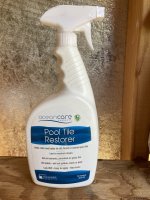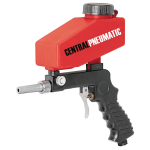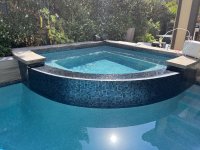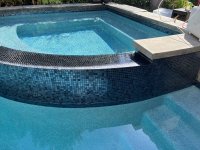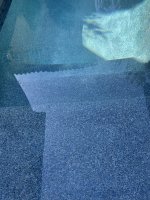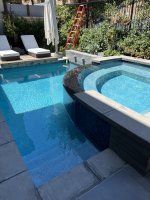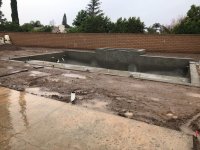UPDATE
Glad to report that the process worked out perfectly!
CH is down to my target 200 from about 600, somehow I nailed it maybe through dumb luck? I added enough PH up until it got below my target so maybe I can take some credit.
Tiles on the spillway already look way better even before doing any cleaning. It seems the lower CH water has dissolved away some of the excess calcium. A layer of hard baked on calcium remains though.
I was able to use a pool vaccum attached to the skimmer to suck out almost all of the CA precipitate.
I used a full bucket of PH increase which is 18 lbs.
Used 1.5 gal of Muratic Acid to get it back to 7.2PH
I did check the CH in the water after the CA settled and it was 125. After vacuuming some is left and so adding this back in when dissolving by decreasing PH brought it up 200. SO, best to get it a bit under your target before raising PH back up.
I did have to wash out my cartridge filter which had a decent amount of CA in it, but was not caked or clogged, pressure only went up about 5 PSI. But it was definitely enough to warrant a good cleaning instead of washing it all back into the pool.
See some updated pictures at the bottom of the thread.
__________
After fighting the past 3 years with calcium build up on the pool tiles at the water line, I decided to try and reduce the CH in the pool water.
Background
When I had a "professional" pool service doing my new pool for the first year, I noticed scale building up on the tiles. I checked the CH and it was 1275, way over the CSI limit. So I fired them and decided to learn what I needed to get the pool properly balanced. The next 2 years it has still had issues even after getting the CH lower.
Initially I did a drain and fill a few times and got CH down to around 600. But this didn't fix the calcium building up.
Recently I again tried doing a couple of 1/3 empty & refills on the pool which did help but only got the CH down to about 575, which is surprising as the tap water CH is only 125. I was expecting to get CH down to 300 or so. CH is generally around 600-700 most of the time. It is lower when I do a drain-fill, but never gets below 575, usually in the 650-675 range. Apparently this is within limits, however I still get a lot of calcium build up along the water line, so it seems not good enough. I'm not sure why it stays above 600 all the time, except maybe the CA is still leeching from the plaster. I thought after 3 years this would be mostly done with. So this whole thing may be a fruitless effort if CA leeching continues and the CH goes right back up to 600+. We will see.
The PH often goes over 8.2 which can increase CSI too high and cause scaling. While I try to add acid at least weekly, it is constantly going over the limit. It pobably goes up .2-.4 per day. It uses a LOT of acid for 8k-10k gallon pool. About 1/3-1/2 gallon per week of muratic acid. Not sure why this is. I have 120 TA so it seems it shouldn't bounce that much? I also have a rather large spa to pool spillway which I understand increases the PH with more air turbulence surface area.
I did a test on a glass of pool water. It worked great, getting CH down to 0-10 range, basically the test sample was blue immediately indicating no CA, didn't have to add any drops to measure it.
I have a large tile spillway from the spa which is in dire need of cleaning to get it back to pristine beautiful condition.
The Fix Attempt
I added about 5 lbs of PH increaser to the pool to increase the PH very high which makes the calcium precipitate and turn into a fine dust which can be (hopefully) vacuumed out of the pool. Not sure exactly how high the PH is, 9.5-11 maybe, can't measure it precisely that high.
I checked the CH and it only went down to 525 from 575. A bit surprised it is still that high with so much CA precipitated already. Possibly the PH is not high enough and there is still a lot of CA in the water.
To vacuum out the CA I'm going to attempt to use a sump pump I have on hand for flushing my hot water heater (coincidentally to also revmove CA scale).
If that doesn't work well enough I will use the pool pump with the pool vacuum attachment, however it goes straight to the filter and there's no backwash capability on my system so I may just have to leave the filter open and let the water drain wherever it goes, otherwise I think most of the CA will simply be pushed through the filter and back into the pool again. It is a very fine powder similar in consistency to Diatomaceous Earth, so I have to dump the water down the drain to get rid of it.
After removing the CA I will add gallons of acid back to bring the PH back to 7.4 and dissolve any remaining CA. In my test with a glass of water this worked out beautifully.
The next day the water level had dropped by 5" in the pool and 2" in the spa. Not sure why execept evaporation? Seems very odd.
Removing Waterline Scale
I have already tried a few options to remove the scale, so far nothing has worked very well.
Pool Details
10k gallon
Saltwater
Plaster (pebble tech)
Tap water is 450 TDS, 125 CH
CH avg 575-675
Glazed Glass tile
Pictures
Added PH increase.
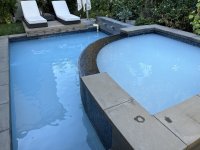
Next day the water dropped 5-6". Why?
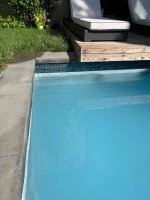
Water was at the tile line, now 5" lower. Also you can see the CA on the step. Don't worry it washed off easily.
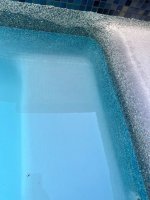
The bane of my existence.
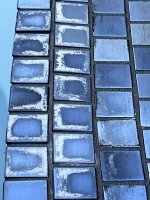
The spillway is a disaster. It looks much better when wet but you can see the obvious buildup that makes it look hazy even when wet.
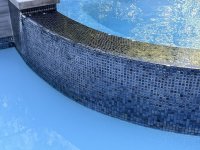
I had already used Calcium release, vinegar and muratic acid on this section. It keeps coming back within 2 weeks.
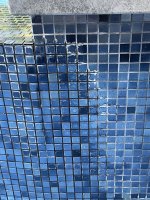
Can see how milky the water is, CA precipitated
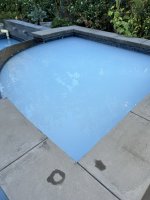
Here you can see the water line scale build up.
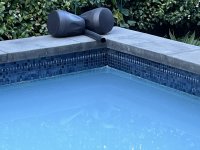
Can barely see the towel I used to plug up the water fill inlet.
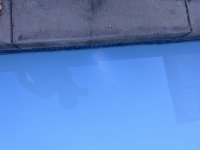
Next day the water level dropped, but also water is much more clear.
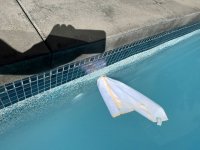
Glad to report that the process worked out perfectly!
CH is down to my target 200 from about 600, somehow I nailed it maybe through dumb luck? I added enough PH up until it got below my target so maybe I can take some credit.
Tiles on the spillway already look way better even before doing any cleaning. It seems the lower CH water has dissolved away some of the excess calcium. A layer of hard baked on calcium remains though.
I was able to use a pool vaccum attached to the skimmer to suck out almost all of the CA precipitate.
I used a full bucket of PH increase which is 18 lbs.
Used 1.5 gal of Muratic Acid to get it back to 7.2PH
I did check the CH in the water after the CA settled and it was 125. After vacuuming some is left and so adding this back in when dissolving by decreasing PH brought it up 200. SO, best to get it a bit under your target before raising PH back up.
I did have to wash out my cartridge filter which had a decent amount of CA in it, but was not caked or clogged, pressure only went up about 5 PSI. But it was definitely enough to warrant a good cleaning instead of washing it all back into the pool.
See some updated pictures at the bottom of the thread.
__________
After fighting the past 3 years with calcium build up on the pool tiles at the water line, I decided to try and reduce the CH in the pool water.
Background
When I had a "professional" pool service doing my new pool for the first year, I noticed scale building up on the tiles. I checked the CH and it was 1275, way over the CSI limit. So I fired them and decided to learn what I needed to get the pool properly balanced. The next 2 years it has still had issues even after getting the CH lower.
Initially I did a drain and fill a few times and got CH down to around 600. But this didn't fix the calcium building up.
Recently I again tried doing a couple of 1/3 empty & refills on the pool which did help but only got the CH down to about 575, which is surprising as the tap water CH is only 125. I was expecting to get CH down to 300 or so. CH is generally around 600-700 most of the time. It is lower when I do a drain-fill, but never gets below 575, usually in the 650-675 range. Apparently this is within limits, however I still get a lot of calcium build up along the water line, so it seems not good enough. I'm not sure why it stays above 600 all the time, except maybe the CA is still leeching from the plaster. I thought after 3 years this would be mostly done with. So this whole thing may be a fruitless effort if CA leeching continues and the CH goes right back up to 600+. We will see.
The PH often goes over 8.2 which can increase CSI too high and cause scaling. While I try to add acid at least weekly, it is constantly going over the limit. It pobably goes up .2-.4 per day. It uses a LOT of acid for 8k-10k gallon pool. About 1/3-1/2 gallon per week of muratic acid. Not sure why this is. I have 120 TA so it seems it shouldn't bounce that much? I also have a rather large spa to pool spillway which I understand increases the PH with more air turbulence surface area.
I did a test on a glass of pool water. It worked great, getting CH down to 0-10 range, basically the test sample was blue immediately indicating no CA, didn't have to add any drops to measure it.
I have a large tile spillway from the spa which is in dire need of cleaning to get it back to pristine beautiful condition.
The Fix Attempt
I added about 5 lbs of PH increaser to the pool to increase the PH very high which makes the calcium precipitate and turn into a fine dust which can be (hopefully) vacuumed out of the pool. Not sure exactly how high the PH is, 9.5-11 maybe, can't measure it precisely that high.
I checked the CH and it only went down to 525 from 575. A bit surprised it is still that high with so much CA precipitated already. Possibly the PH is not high enough and there is still a lot of CA in the water.
To vacuum out the CA I'm going to attempt to use a sump pump I have on hand for flushing my hot water heater (coincidentally to also revmove CA scale).
If that doesn't work well enough I will use the pool pump with the pool vacuum attachment, however it goes straight to the filter and there's no backwash capability on my system so I may just have to leave the filter open and let the water drain wherever it goes, otherwise I think most of the CA will simply be pushed through the filter and back into the pool again. It is a very fine powder similar in consistency to Diatomaceous Earth, so I have to dump the water down the drain to get rid of it.
After removing the CA I will add gallons of acid back to bring the PH back to 7.4 and dissolve any remaining CA. In my test with a glass of water this worked out beautifully.
The next day the water level had dropped by 5" in the pool and 2" in the spa. Not sure why execept evaporation? Seems very odd.
Removing Waterline Scale
I have already tried a few options to remove the scale, so far nothing has worked very well.
- Scraping with a kitchen knife - worked pretty well, but took several hours just to do the spa only, and it was only 90% better.
- Using diluted muratic acid - didn't do much.
- Using full strength muratic acid - worked somewhat, but not completely and ate away grout, loosening tiles.
- Using some water line scale remover product - didn't do anything at all.
- Using muratic acid with a metal brush - didn't do much better than kitchen knife, scratched up the tiles some
- Using pumice stone - destroyed the glass tiles really bad. lol. I will replace them at some point.
- Using a dremel and some various bits to see if any can remove the scale while leaving the glaze on my glass tile intact.
- Using a soda blaster - Gravity Feed Abrasive Blaster Gun with 20 oz. Hopper
Pool Details
10k gallon
Saltwater
Plaster (pebble tech)
Tap water is 450 TDS, 125 CH
CH avg 575-675
Glazed Glass tile
Pictures
Added PH increase.

Next day the water dropped 5-6". Why?

Water was at the tile line, now 5" lower. Also you can see the CA on the step. Don't worry it washed off easily.

The bane of my existence.

The spillway is a disaster. It looks much better when wet but you can see the obvious buildup that makes it look hazy even when wet.

I had already used Calcium release, vinegar and muratic acid on this section. It keeps coming back within 2 weeks.

Can see how milky the water is, CA precipitated

Here you can see the water line scale build up.

Can barely see the towel I used to plug up the water fill inlet.

Next day the water level dropped, but also water is much more clear.

Last edited:


